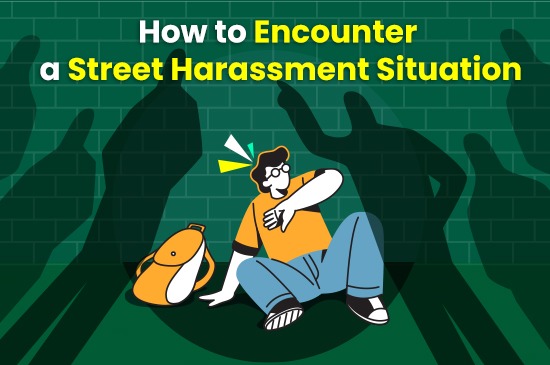Suppose you’re walking home after an amazing day, enjoying your favorite playlist, or scrolling through your phone, when someone shouts an inappropriate comment or starts following you. Your heart races, and that moment of peace is replaced with fear and discomfort. Sounds familiar? Unfortunately, street harassment—whether it’s catcalling, leering, or even physical intimidation—is a reality that too many teens and adults face every day.
Street harassment—a form of unwanted, intrusive behavior in public spaces—comes in many forms. From catcalls and inappropriate comments to stalking and even physical violence, it’s a reality faced by millions of people every day, especially teens navigating their growing independence. In fact, studies show that 65% of women & girls and 25% of men experience street harassment at least once in their lives.
But this isn’t just about the statistics. It’s about how these encounters can disrupt your sense of security, confidence, and peace of mind. Whether it happens on your walk to school, at the mall, or even in a coffee shop, harassment can feel overwhelming—but it doesn’t have to.
This blog is here to help. You’ll learn how to stay safe, de-escalate tense situations, protect yourself with self-defense tips, and understand your rights. Together, we can take steps to stop harassment, empower ourselves, and create safer spaces for everyone. Let’s dive in and take back control.
The Hidden Harm of Street Harassment

Street harassment isn’t just an inconvenience—in today’s society, it’s a persistent issue that disrupts lives and communities. It targets people of all genders but disproportionately affects women, and teenage girls forcing many to live in fear and alter their daily routines. This pervasive issue extends beyond unwanted comments or behaviors; it has profound psychological, emotional, and social consequences. The cumulative effect of harassment often leaves victims feeling anxious, constantly “on edge,” and fearful of being in public spaces. Many are forced to adjust their routines, such as avoiding public transportation, walking less frequently, or spending money on private transportation options they may not be able to afford. For those without such alternatives, the fear of harassment can limit their access to education, employment, and community engagement.
Immediate Actions to Take During a Harassment Situation

In today’s society, street harassment is a harsh reality that countless teenage girls and women face in public spaces. It’s like pollution – it doesn’t hit you right away, but over time, it slowly poisons your peace of mind. History shows us the severity of these incidents, and ignoring them only lets them thrive. But standing up can feel risky. So, how do we stay safe and shift society’s mindset to make harassment truly unacceptable? Let’s take action and reclaim our space!
Here’s how to handle street harassment effectively:
1. Stay Calm and Assess the Situation
Take a deep breath. Stay alert but avoid showing fear—confidence can often disarm potential harassers. Paying attention to your surroundings can help you notice potential problems early and avoid them. Being alert is your first line of defense.
2. Confident Body Language
Carry yourself with calm, respectful confidence. Avoid looking timid or scared, as it might make you a target. Aggression, on the other hand, can escalate a situation. Walk briskly, glance around calmly, and keep moving.
3. Avoid Direct Eye Contact
Eye contact can sometimes be interpreted as an invitation or seen as a challenge. Instead, use “soft eyes” to glance around without focusing on anyone directly. Stay aware, but avoid locking eyes.
4. Change Your Route
It’s worth taking an extra few minutes to avoid problematic areas. If you know certain spots are frequented by harassers, take a different route or cross the street.
5 . Manage Your Emotions
Protect your mental well-being by reframing rude remarks. Imagine throwing hurtful words into a trash can and remind yourself that you owe harassers nothing—not the truth, not a reaction, and not an explanation.
6. Fight Back When Necessary
While leaving the scene is usually the safest option, there may be times when you need to fight back to protect yourself. Confidence and preparation can discourage harassment. Learn self-defense techniques or carry safety tools like a whistle or pepper spray.
Seeking Help and Support
Your safety is more important than anyone’s discomfort. If you feel unsafe, head to the nearest populated area, interrupt someone, and explain the situation. Share your experience with friends or report it to authorities. If harassment affects you emotionally, seek counseling. In case of escalation, seek immediate help:
- Reach Out to Nearby People: Loudly asking for help can deter harassers and attract attention.
- Contact law enforcement: If the harassment crosses legal boundaries, don’t hesitate to call for help.
- Use safety apps and hotlines: Apps like ‘112 India’ and ‘My Safetipin’ help you stay safe in emergencies. They allow you to send SOS alerts, share your location, and get real-time updates on safe routes and danger zones, ensuring quick help from trusted contacts.
Self-Defense Tips for Street Safety
Empowering yourself with self-defense techniques can give you the confidence to face harassment situations head-on.
1. Learn Basic Self-Defense Moves
Simple techniques like striking sensitive areas (eyes, nose, or knees) can help create an opportunity to escape.
2. Carry Safety Tools
Pepper spray, a whistle, or even a keychain alarm can serve as effective deterrents. Always keep them accessible!
3. Take Self-Defense Classes
Joining a class not only equips you with skills but also boosts your confidence. Look for local programs tailored for teens.
Long-Term Strategies to Prevent Street Harassment
While self-defense is crucial, let’s also address the bigger picture:
- Report incidents: Even if it feels small, reporting harassment can lead to better safety policies in your community.
- Educate others: Talk to friends and family about harassment and how to combat it.
- Build safety networks: Form groups that look out for each other during commutes or walks.
How to Support Others in Harassment Situations
You might not always be the victim, but being a bystander gives you the chance to make a difference.
- Intervene safely: If you see someone being harassed, offer help by standing close or asking if they need assistance.
- Offer emotional support: Sometimes, just listening to someone share their experience can make a huge difference.
Conclusion
It’s a sad reality that in the present day, no woman or teenage girl can deny having been accosted in public. This issue highlights the need for societal change, stronger laws, and more awareness about respecting boundaries and personal space. Education, both in terms of teaching respect and self-defense, as well as creating safe environments, is crucial in addressing this problem. Street harassment isn’t something we should silently endure. It’s time to reclaim the streets and stand up for our right to feel safe.
Stay Aware, Stay Prepared, and Empower Others To Stand Against Harassment.
Share this blog to raise awareness and equip your friends and community with tools to combat street harassment. Together, we can build a world where street harassment is a thing of the past.
FAQs (Frequently Asked Questions)
What should I do if I feel unsafe during harassment?
Move to a crowded or well-lit area, seek help, and use a safety app to alert someone.
Are there specific tools for street safety?
Yes, tools like pepper spray, personal alarms, and safety apps can be lifesavers.
How can communities work together to reduce harassment?
Communities can create safety groups, host workshops, and advocate for stronger anti-harassment policies.
What should I do if I’m harassed?
Stay composed, change your route if possible, seek help from others nearby, and report the incident to authorities if necessary.
How can I defend myself?
Learn basic self-defense techniques, carry safety tools like pepper spray, and consider joining a self-defense class to boost your confidence.
How can I help others being harassed?
If you witness harassment, offer support, stand near the person, or help them find a safer place. Listen to their experience and validate their feelings.









